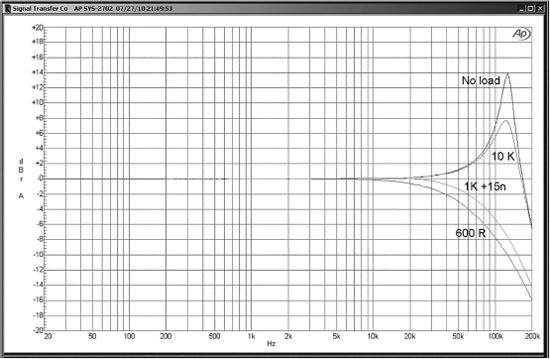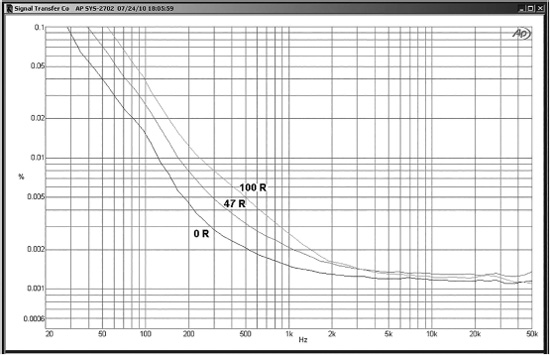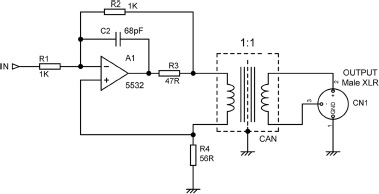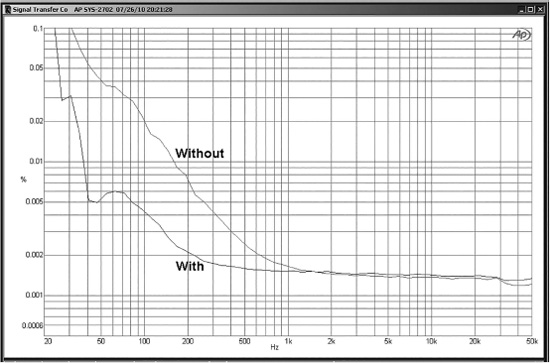Chapter 21
Line Outputs
Unbalanced Outputs
There are only two electrical output terminals for an unbalanced output—signal and ground. However, the unbalanced output stage in Figure 21.1a is fitted with a three-pin XLR connector to emphasise that it is always possible to connect the cold wire in a balanced cable to the ground at the output end and still get all the benefits of common-mode rejection, if you have a balanced input. If a two-terminal connector is fitted, the link between the cold wire and ground has to be made inside the connector, as shown in Figure 20.2 in the chapter on line inputs.
The output amplifier in Figure 21.1a is configured as a unity-gain buffer, though in some cases it will be connected as a series-feedback amplifier to give gain. A non-polarised DC-blocking capacitor C1 is included; 100 uF gives a −3 dB point of 2.6 Hz with one of those notional 600 Ω loads. The opamp is isolated from the line shunt-capacitance by a resistor R2, in the range 47–100 Ω, to ensure HF stability, and this unbalances the hot and cold line impedances. A drain resistor R1 ensures that no charge can be left on the output side of C1; it is placed before R2, so it causes no attenuation. In this case the loss would only be 0.03 dB, but such errors can build up to an irritating level in a large system, and it costs nothing to avoid them.
If the cold line is simply grounded as in Figure 21.1a, then the presence of R2 degrades the CMRR of the interconnection to an uninspiring −43 dB, even if the balanced input at the other end of the cable has infinite CMRR in itself and perfectly matched 10 kΩ input impedances.
To fix this problem, Figure 21.1b shows what is called an impedance-balanced output. The cold terminal is neither an input nor an output but a resistive termination R3 with the same resistance as the hot terminal output impedance R2. If an unbalanced input is being driven, this cold terminal is ignored. The use of the word “balanced” is perhaps unfortunate, as when taken together with an XLR output connector it implies a true balanced output with anti-phase outputs, which is not what you are getting. The impedance-balanced approach is not particularly cost-effective, as it requires significant extra money to be spent on an XLR connector. Adding an opamp inverter to make it a proper balanced output costs little more, especially if there happens to be a spare opamp half available, and it sounds much better in the specification.
There is an instance of the use of impedance-balancing in the active crossover design example in Chapter 23; here the outputs come directly from low-impedance level trim controls with output impedances that vary somewhat with the level settings, so compromise values for the impedance-balancing resistances must be used.
Active crossover output stages may also incorporate level trim controls, mute switches, and phase-invert switches. These features are covered in Chapter 17 on crossover system design.
Zero-Impedance Outputs
Both the unbalanced outputs shown in Figure 21.1 have series output resistors to ensure stability when driving cable capacitance. This increases the output impedance and can lead to increased crosstalk in some situations, notably when different signals are being passed down the same signal cable. This is a particular problem when two or more layers of ribbon cable are laid together in a “lasagne” format for neatness or to save space. In some cases layers of grounded screening foil are interleaved with the cables, but this is rather expensive and awkward to do and does not greatly reduce crosstalk between conductors in the same piece of ribbon. The best way to deal with this is to reduce the output impedance.
A simple but very effective way to do this is the so-called “zero-impedance” output configuration. Figure 21.2a shows how the technique is applied to an unbalanced output stage with 10 dB of gain. Feedback at audio frequencies is taken from outside isolating resistor R3 via R2, while the HF feedback is taken from inside R3 via C2, so it is not affected by load capacitance and stability is unimpaired. Using a 5532 opamp, the output impedance is reduced from 68 ohms to 0.24 ohms at 1 kHz—a dramatic reduction that will reduce purely capacitive crosstalk by an impressive 49 dB. The output impedance increases to 2.4 ohms at 10 kHz and 4.8 ohms at 20 kHz, as opamp open-loop gain falls with frequency. The impedance-balancing resistor on the cold pin has been replaced by a link to match the near-zero output impedance at the hot pin.
Figure 21.2b shows a refinement of this scheme with three feedback paths. Electrolytic coupling capacitors can introduce distortion if they have more than a few tens of millivolts of signal across them, even if the time-constant is long enough to give a virtually flat LF response. (This is looked at in detail in Chapter 15 on passive components.) In Figure 21.2b, most of the feedback is now taken from outside C1 via R5, so it can correct capacitor distortion. The DC feedback goes via R2, now much higher in value, and the HF feedback goes through C2, as before, to maintain stability with capacitive loads. R2 and R5 in parallel come to 10 kΩ, so the gain is the same. Any circuit with separate DC and AC feedback paths must be checked carefully for frequency response irregularities, which may happen well below 10 Hz.
Ground-Cancelling Outputs
This technique, also called a ground-compensated output, appeared in the early 1980s in mixing consoles. It allows ground voltages to be cancelled out even if the receiving equipment has an unbalanced input; it prevents any possibility of creating a phase error by mis-wiring; and it costs virtually nothing in itself, though it does require a three-pin output connector.
Ground-cancelling (GC) separates the wanted signal from the unwanted ground voltage by addition at the output end of the link rather than by subtraction at the input end. If the receiving equipment ground differs in voltage from the sending ground, then this difference is added to the output signal so that the signal reaching the receiving equipment has the same ground voltage superimposed upon it. Input and ground therefore move together, and the ground voltage has no effect, subject to the usual effects of component tolerances. The connecting lead is differently wired from the more common unbalanced-out balanced-in situation, as now the cold line is joined to ground at the input or receiving end.
An inverting unity-gain ground-cancel output stage is shown in Figure 21.3a. The cold pin of the output socket is now an input and has a unity-gain path summing into the main signal going to the hot output pin to add the ground voltage. This path R3, R4 has a very low input impedance equal to the hot terminal output impedance, so if it is used with a balanced input, the line impedances will be balanced, and the combination will still work effectively. The 6 dB of attenuation in the R3-R4 divider is undone by the gain of two set by R5, R6. It is unfamiliar to most people to have the cold pin of an output socket as a low-impedance input, and its very low input impedance minimises the problems caused by mis-wiring. Shorting it locally to ground merely converts the output to a standard unbalanced type. On the other hand, if the cold input is left unconnected, then there will be a negligible increase in noise due to the very low input resistance of R3.
This is the most economical GC output, but obviously the phase inversion is not always convenient. Figure 21.3b shows a non-inverting GC output stage with a gain of 6.6 dB. R5 and R6 set up a gain of 9.9 dB for the amplifier, but the overall gain is reduced by 3.3 dB by attenuator R3, R4. The cold line is now terminated by R7, and any signal coming in via the cold pin is attenuated by R3, R4 and summed at unity gain with the input signal. A non-inverting GC stage must be fed from a very low impedance such as an opamp output to work properly. There is a slight compromise on noise performance here because attenuation is followed by amplification.
Ground-cancelling outputs are an economical way of making ground loops innocuous when there is no balanced input, and it is rather surprising they are not more popular; perhaps people find the notion of an input pin on an output connector unsettling. In particular GC outputs offer the possibility of a quieter interconnection than the standard balanced interconnection, because a relatively noisy balanced input is not required (see Chapter 20 on line inputs). Ground-cancelling outputs can also be made zero impedance using the techniques described earlier.
Balanced Outputs
Figure 21.3c shows a balanced output, where the cold terminal carries the same signal as the hot terminal but phase inverted. This can be arranged simply by using an opamp stage to invert the normal in-phase output. The resistors R3, R4 around the inverter should be as low in value as possible to minimise Johnson noise, because this stage is working at a noise gain of 2, but bear in mind that R3 is effectively grounded at one end, and its loading, as well as the external load, must be driven by the first opamp. A unity-gain follower is shown for the first amplifier, but this can be any other shunt or series-feedback stage as convenient. The inverting output, if not required, can be ignored; it must not be grounded, because the inverting opamp will then spend most of its time clipping in current-limiting, almost certainly injecting unpleasantly crunching distortion into the crossover grounding system. Both hot and cold outputs must have the same output impedances (R2, R6) to keep the line impedances balanced and the interconnection CMRR maximised.
It is vital to realise that this sort of balanced output, unlike transformer balanced outputs, by itself gives no common-mode rejection at all. It must be connected to a balanced input which can subtract one output from another if ground noise is to be cancelled.
The only advantages that this kind of balanced output has over an unbalanced output is that the total signal level on the interconnection is increased by 6 dB, which if correctly handled can improve the signal-to-noise ratio. It is also less likely to crosstalk to other lines, even if they are unbalanced, as the currents injected via the stray capacitance from each line will tend to cancel; how well this works depends on the physical layout of the conductors. All balanced outputs give the facility of correcting phase errors by swapping hot and cold outputs. This is however a two-edged sword, because it is probably how the phase got wrong in the first place.
There is no need to worry about the exact symmetry of level for the two output signals; ordinary 1% tolerance resistors are fine. Slight gain differences between the two outputs only affect the signal-handling capacity of the interconnection by a very small amount. This simple form of balanced output is the norm in hi-fi balanced interconnection but is less common in professional audio, where the quasi-floating output, which emulates a transformer winding, gives both common-mode rejection and more flexibility in situations where temporary connections are frequently being made.
Transformer Balanced Outputs
If true galvanic isolation between equipment grounds is required, this can only be achieved with a line transformer, sometimes called a line isolating transformer; don’t confuse them with mains isolating transformers. You don’t, as a rule, use line transformers unless you really have to, because the much-discussed cost, weight, and performance problems are very real, as you will see shortly. However they are sometimes found in big sound-reinforcement systems and in any environment where high RF field strengths are encountered. They are unlikely to be used in active crossovers for domestic hi-fi. A basic transformer balanced output is shown in Figure 21.4a; in practice A1 would also have some other function such as providing gain or filtering. In good-quality line transformers there will be an inter-winding screen, which should be earthed to minimise noise pickup and general EMC problems. In most cases this does not ground the external can, and you have to arrange this yourself, possibly by mounting the can in a metal capacitor clip. Make sure the can is earthed, as this definitely does reduce noise pickup.
Be aware that the output impedance will be higher than usual because of the ohmic resistance of the transformer windings. With a 1:1 transformer, as normally used, both the primary and secondary winding resistances are effectively in series with the output. A small line transformer can easily have 60 Ω per winding, so the output impedance is 120 Ω plus the value of the series resistance R1 added to the primary circuit to prevent HF instability due to transformer winding capacitances and line capacitances. The total can easily be 160 Ω or more, compared with, say, 47 Ω for non-transformer output stages. This will mean a higher output impedance and greater voltage losses when driving heavy loads.
DC flowing through the primary winding of a transformer is bad for linearity, and if your opamp output has anything more than the usual small offset voltages on it, DC current flow should be stopped by a blocking capacitor.
Output Transformer Frequency Response
If you have looked at the section in Chapter 20 on the frequency response of line input transformers, you will recall that they give a nastily peaking frequency response if the secondary is not loaded properly, due to resonance between the leakage inductance and the stray winding capacitances. Exactly the same problem afflicts output transformers, as shown in Figure 21.5; with no output loading there is a frightening 14 dB peak at 127 kHz. This is high enough in frequency to have very little effect on the response at 20 kHz, but such a high-Q resonance isn’t the sort of horror you want lurking in your circuitry. It could easily cause some nasty EMC problems.
The transformer measured was a Sowter 3292 1:1 line isolating transformer. Sowter are a highly respected company, and this is a quality part with a mumetal core and housed in a mumetal can for magnetic shielding. When used as the manufacturer intended, with a 600 Ω load on the secondary, the results are predictably quite different, with a well-controlled roll-off that I measured as −0.5 dB at 20 kHz.
The difficulty is that there are very few if any genuine 600 Ω loads left in the world, and most output transformers are going to be driving much higher impedances. If we are driving a 10 kΩ load, the secondary resonance is not much damped, and we still get a thoroughly unwelcome 7 dB peak above 100 kHz, as shown in Figure 21.5. We could of course put a permanent 600 Ω load across the secondary, but that will heavily load the output opamp, impairing its linearity, and will give us unwelcome signal loss due in the winding resistances. It is also profoundly inelegant.
A better answer, as in the case of the line input transformer, is to put a Zobel network, i.e. a series combination of resistor and capacitor, across the secondary, as in Figure 21.4b. The capacitor required is quite small and will cause very little loading, except at high frequencies where signal amplitudes are low. A little experimentation yielded the values of 1 kΩ in series with 15 nF, which gives the much improved response shown in Figure 21.5. The response is almost exactly 0.0 dB at 20 kHz, at the cost of a very gentle 0.1 dB rise around 10 kHz; this could probably be improved by a little more tweaking of the Zobel values. Be aware that a different transformer type will require different values.
Transformer Distortion
Transformers have well-known problems with linearity at low frequencies. This is because the voltage induced into the secondary winding depends on the rate of change of the magnetic field in the core, and so the lower the frequency, the greater the change in field magnitude must be for transformer action. [1] The current drawn by the primary winding to establish this field is non-linear, because of the well-known non-linearity of iron cores. If the primary had zero resistance and was fed from a zero source impedance, as much distorted current as was needed would be drawn, and no one would ever know there was a problem. But … there is always some primary resistance, and this alters the primary current drawn so that third-harmonic distortion is introduced into the magnetic field established and so into the secondary output voltage. Very often there is a series resistance R1 deliberately inserted into the primary circuit, with the intention of avoiding HF instability; this makes the LF distortion problem worse. An important point is that this distortion does not appear only with heavy loading—it is there all the time, even with no load at all on the secondary; it is not analogous to loading the output of a solid-state power amplifier, which invariably increases the distortion. In fact, in my experience transformer LF distortion is slightly better when the secondary is connected to its rated load resistance. With no secondary load, the transformer appears as a big inductance, so as frequency falls the current drawn increases, until with circuits like Figure 21.4a, there is a sudden steep increase in distortion around 10–20 Hz as the opamp hits its output-current limits. Before this happens the distortion from the transformer itself will be gross.
To demonstrate this I did some distortion tests on the same Sowter 3292 transformer. The winding resistance for both primary and secondary is about 59 Ω. It is quite a small component, 34 mm in diameter and 24 mm high and weighing 45 gm, and is obviously not intended for transferring large amounts of power at low frequencies. Figure 21.6 shows the LF distortion with no series resistance, driven directly from a 5532 output (there were no HF stability problems in this case, but it might be different with cables connected to the secondary), and with 47 and 100 Ω added in series with the primary. The flat part to the right is the noise floor.
Taking 200 Hz as an example, adding 47 Ω in series increases the THD from 0.0045% to 0.0080%, figures which are in exactly the same ratio as the total resistances in the primary circuit in the two cases. It’s very satisfying when a piece of theory slots right home like that. Predictably, a 100 Ω series resistor gives even more distortion, namely 0.013% at 200 Hz, and once more proportional to the total primary circuit resistance.
If you’re used to the near-zero LF distortion of opamps, you may not be too impressed with Figure 21.6, but this is the reality of output transformers. The results are well within the manufacturer’s specifications for a high-quality part. Note that the distortion rises rapidly to the LF end, roughly tripling as frequency halves. It also increases fast with level, roughly quadrupling as level doubles. Having gone to some pains to make electronics with very low distortion, this non-linearity at the very end of the signal chain is distinctly irritating.
The situation is somewhat eased in actual use, as signal levels in the bottom octave of audio are normally about 10–12 dB lower than the maximum amplitudes at higher frequencies; see Chapter 17 for more on this.
Reducing Transformer Distortion
In electronics, as in so many other areas of life, there is often a choice between using brains or brawn to tackle a problem. In this case “brawn” means a bigger transformer, such as the Sowter 3991, which is still 34 mm in diameter but 37 mm high, weighing in at 80 gm. The extra mumetal core material improves the LF performance, and thicker wire may be helping by lowering winding resistance, but you still get a distortion plot very much like Figure 21.6 (with the same increase of THD with series resistance), except now it occurs at 2 Vrms instead of 1 Vrms. Twice the metal, twice the level—I suppose it makes sense. You can take this approach a good deal further with the Sowter 4231, a much bigger open-frame design tipping the scales at a hefty 350 gm. The winding resistance for the primary is 12 Ω and for the secondary 13.3 Ω, both a good deal lower than the previous figures.
Figure 21.7 shows the LF distortion for the 4231 with no series resistance, and with 47 and 100 Ω added in series with the primary. The flat part to the right is the noise floor. Comparing it with Figure 21.5, the basic distortion at 30 Hz is now 0.015%, compared with about 0.10% for the 3292 transformer. While this is a useful improvement, it is gained at considerable expense. Now adding 47 Ω of series resistance has dreadful results—distortion increases by about five times. This is because the lower winding resistances of the 4231 mean that the added 47 Ω has increased the total resistance in the primary circuit to five times what it was. Predictably, adding a 100 Ω series resistance approximately doubles the distortion again. In general bigger transformers have thicker wire in the windings, and this in itself reduces the effect of the basic core non-linearity, quite apart from the improvement due to more core material. A lower winding resistance also means a lower output impedance.
The LF non-linearity in Figure 21.7 is still most unsatisfactory compared with that of the electronics. Since the “My policy is copper and iron!” [2] approach does not solve the problem, we’d better put brawn to one side and try what brains we can muster.
We have seen that adding series resistance to ensure HF stability makes things definitely worse, and a better means of isolation is a low-value inductor of, say, 4 uH paralleled with a low-value damping resistor of around 47 Ω. However, inductors cost money, and a more economic solution is to use a zero-impedance output as shown in Figure 21.4b. This gives the same results as no series resistance at all but with dependable HF stability. However, the basic transformer distortion remains because the primary winding resistance is still there, and its level is still too high. What can be done?
The LF distortion can be reduced by applying negative feedback via a tertiary transformer winding, but this usually means an expensive custom transformer, and there may be some interesting HF stability problems because of the extra phase-shift introduced into the feedback by the tertiary winding; this approach is discussed in [3]. What we really want is a technique that will work with off-the-shelf transformers.
A better way is to cancel out the transformer primary resistance by putting in series an electronically generated negative resistance; the principle is shown in Figure 21.8, where a zero-impedance output is used to eliminate the effect of the series stability resistor. The 56 Ω resistor R4 senses the current through the primary and provides positive feedback to A1, proportioned so that a negative output resistance of twice the value of R4 is produced, which will cancel out both R4 itself and the primary winding resistance. As we saw earlier, the primary winding resistance of the 3292 transformer is approximately 59 Ω, so if R4 was 59 Ω we should get complete cancellation. But …
It is always necessary to use positive feedback with caution. Typically it works, as here, in conjunction with good old-fashioned negative feedback, but if the positive exceeds the negative (this is one time you do not want to accentuate the positive), then the circuit will typically latch up solid, with the output jammed up against one of the supply rails. R4 = 56 Ω in Figure 21.8 worked reliably in all my tests, but increasing R4 to 68 Ω caused immediate problems, which is precisely what you would expect. No input blocking capacitor is shown in Figure 21.8, but it can be added ahead of R1 without increasing the potential latch-up problems.
This circuit is only a basic demonstration of the principle of cancelling primary resistance, but as Figure 21.9 shows it is still highly effective. The distortion at 100 Hz is reduced by a factor of five, and at 200 Hz by a factor of four. Since this is achieved by adding one resistor, I think this counts as a triumph of brains over brawn and indeed is confirmation of the old adage that size is less important than technique.
The method is sometimes called “mixed feedback”, as it can be looked at as a mixture of voltage and current feedback. The principle can also be applied when a balanced drive to the output transformer is used. Since the primary resistance is cancelled, there is a second advantage, as the output impedance of the stage is reduced. The secondary winding resistance is however still in circuit, and so the output impedance is usually only halved.
If you want better performance than this—and it is possible to make transformer non-linearity effectively invisible down to 15 Vrms at 10 Hz—there are several deeper issues to consider. The definitive reference is Bruce Hofer’s patent, which covers the transformer output of the Audio Precision measurement systems. [4] There is also more information in the Analog Devices Opamp Applications Handbook. [5]
References
[1]Sowter, Dr G. A. V. “Soft Magnetic Materials for Audio Transformers: History, Production, and Applications” JAES 35(10), October 1987, p. 769
[2]Bismarck, Otto von Speech Before the Prussian Landtag Budget Committee, 1862 (actually, he said blood and iron).
[3]Finnern, Thomas “Interfacing Electronics and Transformers” AES preprint #2194 77th AES Convention. Hamburg, March 1985
[4]Hofer, Bruce Low-Distortion Transformer-Coupled Circuit US Patent 4,614,9141986
[5]Jung, Walt (ed.) “Opamp Applications Handbook” Newnes, 2004, Ch 6, pp. 484–491, ISBN 13: 978-0-7506-7844-5









